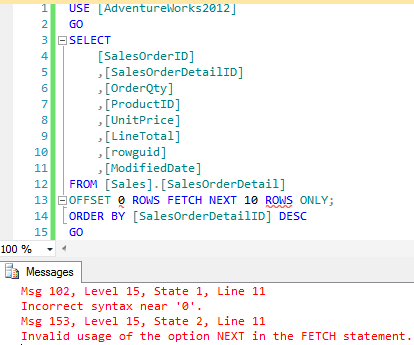
Setup a private space for you and your coworkers to ask questions and share information. SQL Query: Need order by count, most must be on. SQL COUNT ( ) with group by and order by In this page, we are going to discuss the usage of GROUP BY and ORDER BY along with the SQL COUNT () function. The GROUP BY makes the result set in summary rows by the value of one or more columns.

Mit SELECT kann man Daten auswählen und mit WHERE genau bestimmen, was ausgewählt werden soll. Nun kann man so eine Abfrage noch um einen weiteren Befehl. SQL COUNT () Funktion Die SQL COUNT -Funktion zählt( COUNT ) die Anzahl von ausgewählten Datensätzen. Für diese Aggregatfunktion gibt man einfach das Schlüsselwort COUNT an, inklusive der Spalte der zu zählenden Datensätzen in den Klammern an. Mit dem SQL Befehl GROUP BY kann man Daten gruppieren.
Interessant sind Gruppierungen vor allem in Kombination mit Aggregatfunktionen, wie z. However, I want to sort by the. SQL HOME SQL Intro SQL Syntax SQL Select SQL Select Distinct SQL Where SQL An Or, Not SQL Order By SQL Insert Into SQL Null Values SQL Update SQL Delete SQL Select Top SQL Min and Max SQL Count , Avg, Sum SQL Like SQL Wildcards SQL In SQL Between SQL Aliases SQL Joins SQL Inner Join SQL Left Join SQL Right Join SQL Full Join SQL Self Join SQL Union SQL Group By SQL Having SQL Exists SQL Any. For example, the following statement gets the number of employees for each department and sorts the result set based on the number of employees in descending order.
Durch das SQL GROUP BY–Statement ist es möglich eine Ergebnismenge zu gruppieren. Dieser SQL -Befehl wird häufig in Kombination mit den Aggregatfunktionen verwendet. By default, ORDER BY sorts in ascending order. When it comes to numbers, that means smallest first.
If we want to find the rows with the largest count values, we use the DESC keyword. SQL ORDER BY Descending and ascending Command The we get from a table we may have to display in an order. Use SQL GROUP BY to summarize query.
Use it with aggregrate functions to perorm summary calculations such as SUM and averages. The ORDER BY clause is used in a SELECT statement to sort either in ascending or descending order. Oracle sorts query in ascending order by default. The SQL ORDER BY clause allows you to sort the result set based on one or more sort keys in ascending or descending order.
Fügen Sie einen weiteren Datensatz ein und lassen bei diesem das Feld DATUM leer, so erhalten Sie mit der obigen Abfrage weiterhin das Ergebnis 9. This SQL tutorial explains how to use the SQL COUNT function with syntax, examples, and practice exercises. Description The SQL COUNT function is used to count the number of rows returned in a SELECT statement. Sie erlaubt die Zählung ( COUNT ) der Zeilen in einer bestimmten Tabelle. In this page we are discussing the usage of SQL COUNT () along with the SQL MAX().
The sql having also be used with sql max function. Wenn man eine Tabelle hat, in der viele Werte doppelt vorkommen, kann man mit dem Schlüsselwort DISTINCT die Selektion von doppelten Werten befreien. The easy way is simply to sort the MAX query into descending order by totalcontracts and use TOP or LIMIT or a similar mechanism. In this tutorial, you will learn about the SQL COUNT function that returns the number of rows in a specified table. If an ORDER BY clause is omitte then a particular order to the output rows, such as the order in which the rows are encountered in the queried table, cannot be guaranteed—even if an index is present.
Without an ORDER BY clause , the order of the output rows is determined by the internal processing of PROC SQL , the default collating sequence of SAS, and your operating environment. SQL ist eine Datenbanksprache zur Definition von Datenstrukturen in relationalen Datenbanken sowie zum Bearbeiten (Einfügen, Verändern, Löschen) und Abfragen von darauf basierenden Datenbeständen. Die Sprache basiert auf der relationalen Algebra, ihre.
SQL gives you options for retrieving, analyzing, and displaying the information you need with the GROUP BY, HAVING, and ORDER BY clauses. Here are some examples of how you can use them. SQL Server GROUP BY clause and aggregate functions In practice, the GROUP BY clause is often used with aggregate functions for generating summary reports.
An aggregate function performs a calculation on a group and returns a unique value per group. The ORDER BY statement in sql is used to sort the fetched data in either ascending or descending according to one or more columns. We can use the keyword DESC to sort the data in descending order and the keyword ASC to sort in ascending order.
May as well drop the parenthesis as not needed. La commande GROUP BY est utilisée en SQL pour grouper plusieurs résultats et utiliser une fonction de totaux sur un groupe de résultat. Sur une table qui contient toutes les ventes d’un magasin, il est par exemple possible de liste regrouper les ventes par clients identiques et d’obtenir le coût total des achats pour chaque client.
Keine Kommentare:
Kommentar veröffentlichen
Hinweis: Nur ein Mitglied dieses Blogs kann Kommentare posten.